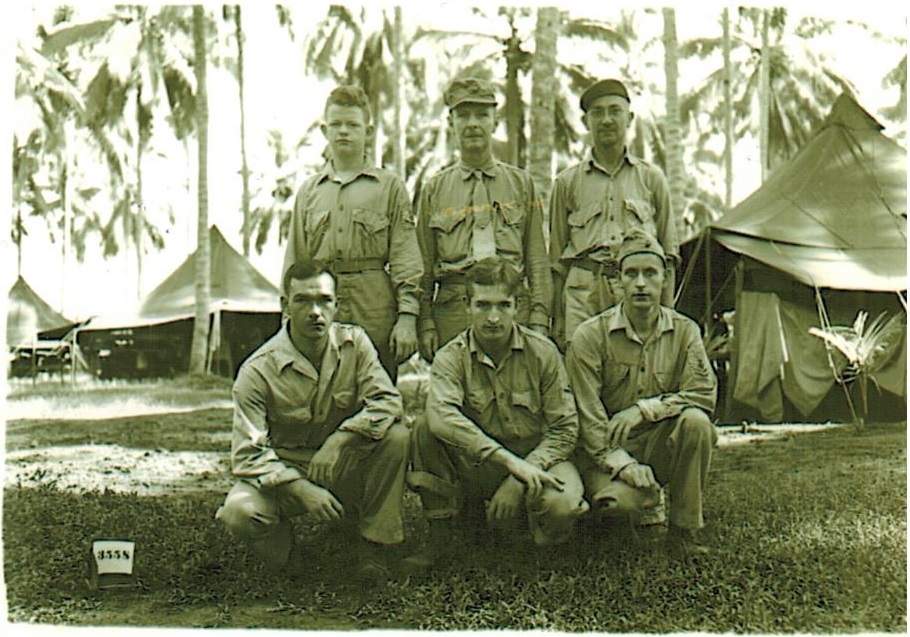
Biography of Ken Rulf
PhM2, D Company, 3rd Medical Battalion, 3rd Marine Division, Fleet Marine Force, USNR
In March of 1943 I enlisted in the USNR while still in high school at the age of 17 in order to avoid being drafted into the army( as an older brother was a month earlier). Did my boot camp training at Great Lakes Naval Training Center under the careful "direction" of Chief Purdy. Since he was about 6'5" and about 270 pounds, there was no problem in his getting our attention.
After boot camp I went to Hospital Corps School, did hospital wand duty for awhile, followed by some Dispensary duty, all of this at Great Lakes. Late in 1943, with winter approaching, noticed a bulletin asking for volunteers for a transfer to Corona Naval Hospital located near Riverside, California. Was "too good to be true" so I volunteered.
After a couple of months there followed a transfer to Field Medical School at Camp Elliot, San Diego. That was my introduction to the Marines.
In 1943, navy boot camp was fairly short, about nine weeks I think. The same with Hospital Corps School -- in peacetime that was six months long; for us, it was six weeks. It was a fairly intense course. The Field Medical School with the Fleet Marine Force (FMF) at Camp Elliott was close to thirteen weeks as I recall; it covered not only field medical training, but basic Marine field training.
After an intensive 13- week program of training we were on our way to the Pacific on board the USAT Robin Doncaster. After a couple of days at a replacement center at Noumea, North Caledonia, we were on our way to become attached to the 3rd Marine division, Fleet Marine Force.
I joined D Co in May 1944 as one of a number of replacements brought in when the division returned to Guadalcanal after the campaign at Bougainville. The division was bivouacked in the old coconut grove plantation of Guadalcanal. I was one of 35 hospital corpsmen assigned to the 3rd Medical Battalion; by luck of the alphabet, I was assigned to D Co which, along with E Co, would make up the Division Field Hospital.
The Table of Organization for each company, A thru E, was 70 enlisted hospital corpsmen plus about 20-25 Marines; I don't recall how many officers (doctors) we had, but it was about seven. A, B, and C companies were each attached to an infantry regiment to serve as Regimental Aid Stations. D and E companies worked closely together to operate, in our case, the 3rd Marine Division Field Hospital. In addition there was an H&S company (Headquarters & Service) that the other companies reported to.
I was there for only a matter of weeks. I am sure that during the weeks that I was on the 'canal that activity on the island must have been busy, but in our location it was fairly quiet. In the few weeks that I was there about all we did was get acclimated to the work outlined for a medical battalion.
The division was camped for the most part in what was a coconut grove owned by the British-owned Colgate-Palmolive soap company. One of first orders we were given, very emphatically, was not to even look at the native women.
Apparently, the men were very possessive and would become extremely riled and upset if any of us would even look at one of their women. The only natives that I ever saw were what we used to refer to the "fuzzie-wuzzies." I do recall the men liked to get their hands on peroxide, I think it was, so as to dye their hair a bright orange.
Cannot recall ever leaving the coconut grove until it was time to board ship and head for the rendevous point in the Marshall Islands. We were off shore there for about six weeks while all of the forces for the Marianas Islands campaigns were being brought together. As you know, Guam was just one; Saipan, Tinian and Rota were invaded just prior to Guam. They had been Japanese territory prior to the war whereas Guam had been taken from us.
On July 21st the division was involved with the invasion of Guam. D Co landed about three hours after the initial landings. For about the first full week of the campaign we had established a temporary hospital in a small draw just across the road from, as I recall, Asan Point. Early on the morning of July 26th we were on the receiving end of a "banzai" charge by a small group of drunken Japanese soldiers. It was quickly repulsed and we suffered some casualties. I recall that Herbie Payne from Arizona dispatched seven of the Japanese (he used to hunt mountain lions as a kid). Herbie was awarded the Bronze Star for his valor during this attack on our temporary hospital.
Towards the end of the month we moved our hospital into the capital city of Agana using what remained of the original U S Navy Hospital located there. The buildings were in pretty good shape considering and we did set up several tents primarily for combat fatigue cases. I did night duty in those for awhile and recall the Army setting up one of their 155mm "Long Toms" nearby . . . they would fire off one round about every 15 minutes all night long to harass the Japanese in the hills. Each time they fired a round I would be running around the ward handing out nembutal tablets to quiet my patients.
The campaign lasted about 30 days; when the island was declared "secure" the Division Field Hospital was moved across the island to Ylig Bay. The facilities in Agana were turned over to Civil Affairs to provide for medical help to the civilian population of Guam. These people suffered long and hard under the Japanese occupation and they deserved all the help that could be provided.
Early in 1945 the 3rd Marine Division was preparing for an operation that turned out to be the invasion of Iwo Jima. The initial plan, though, was for the division to be held in reserve; if all went well at Iwo they would proceed to capture the Bonin Islands. D Co was detached from the division to serve as part of the medical team to use the USS Ozark, LSV2, as an auxiliary hospital ship at Iwo Jima.
There were a large number of Navy medical personnel from all over the Pacific who made up this medical team. The Ozark had a huge vehicle deck with a ramp at the stern; en route to Iwo Jima this deck was crammed full of trailers loaded with supplies. There must have been other cargo on deck 'cause one photo shows a trailer being lowered over the side. The plan was to rapidly unloaded these trailers at the start of the invasion and then convert the vehicle deck into a hospital facility.
It was my understanding that all of the equipment that had been loaded on the vehicle deck was to be just shoved off the ramp and they would float until picked up by amphib tractors. An unexpected delay occurred when many of these trailers began to sink under their own weight. That wasn't supposed to happen, but It became necessary to wait for amphibious tractors to hook on to them so as to not lose those supplies. This obviously did cause a delay in getting our hospital ready to go.
We began accepting casualties on board sometime around five in the afternoon on that first day. The regular hospital ships would pull out to sea after dark to avoid being hit, but the Ozark stayed close in. We were open for business all day and all night. So many of the landing craft from other ships were being lost that we began "loaning" ours to help out. Some of the landing craft crewmen told us that the beaches were so cluttered with destroyed craft that they had trouble finding a place to land themselves.
My function was primarily Record Office work which was the easy part. The "heavy lifting" was the work performed by the surgeons and their operating room teams. I particularly recall the work of Dr. Kaplan of New York City, Dr. Spencer from Michigan and a Dr. Leverault from Massachusetts. At one point, Dr .Spencer performed 18 straight surgeries before taking a short break-he then checked on his patients before getting some rest.
The battle on the island became so intense that the 3rd Marine Division was brought in to join in the fighting. Casualties were so high that, at one point, Dr .Kaplan (our CO) was ordered to pull 28 hospital corpsmen from D Co to go in as replacements. I was asked to make a list of the 28 to be transferred; as an E-5, I respectfully refused to do this. Do not recall who made the selections, but of the 28 who were sent ashore, 7 were killed and 11 were wounded within just a few days.
By the time the battle had ended we had handled about 600 casualties. Even with the excellent medical facilities we had, our mortality rate was very high. As I recall it was about five percent. We returned to Saipan to offload most of the wounded and then D Co returned to Guam and our old facility at Ylig Bay.
Almost immediately, some members of our company participated in the invasion of Okinawa with most of us remaining at Ylig Bay. Like most of the armed forces in the Pacific, the 3rd Marine Division was in constant training for what we all expected to be the eventual invasion of the Japanese mainland. This was, of course, all the more expected after the end of the war in Europe.
The Japanese surrender in August of 1945 brought about a great sense of relief. Most of us realized that an invasion of Japan would be a devastating campaign for both sides. In a matter of days most of us, reservists especially, were busy calculating how many points we had earned so we could figure out when it would be our turn to go home.
My turn came in October. Some of us came home on the USS St Louis, a heavy cruiser. Once we landed at Treasure Island in San Francisco, we all scattered for home, sweet home. Don't know about other members of D Co, but I failed to keep in touch with any one of them. But I do think of them at times; guys like Pat O'Day from Pittsburgh, KS; Ralph Smith of Long Beach; M C Hughey from North Carolina; Calvin Louis Edwards of Hopewell, Virginia (he still owes me $20).
D Co, 3rd Medical Battalion, 3rd Marine Division was a good outfit. While not a front line, fighting outfit, we served with distinction; I'm certain that most of us feel that we did what was required and are proud of the service we performed.
After returning home: Had a great 30-day leave during November and December 1945. Needed a few more points before release to inactive duty, so was for the first time a part of a ship's company on board the USS Laurens, APA 153. Since the war was over. We had a virtual "pleasure cruise" from Portland, Oregon to Norfolk, Virginia - no troops and no cargo. Just took her there for decommissioning. So, in March 1946 I took my separation pay and headed for home in Wisconsin.
Had one more "brush" with the USNR. In 1949, while living in Los Angeles, I wanted to join an organized reserve unit there. There was no spot open for an HM2 ( the new rating) so I was put on inactive status. In October 1950 I was called to active duty during the Korean action. After about two or three months at the San Diego Naval Hospital, I was transferred to the Medical Supply Depot located in Oakland, California. Was stationed there until my release to inactive duty in March 1952 when I returned to Los Angeles.
Enclosed are some photos that relate to the USS Ozark during the operation at Iwo Jima along with some of D Co. 3rd Medical Battalion. They are the only photos I can locate from my days with the D Co; I'm sure there is a fourth photo from the USS Ozark, but haven't yet found it. Hope that you can find some of these of some use. Here's a brief description of each:

Six members of D Co on Guadalcanal - was taken between the operations at Bougainville and Guam. The only name I can put to this is Murphy for the one wearing a tie- as I recall, he was 47 years old at the time.
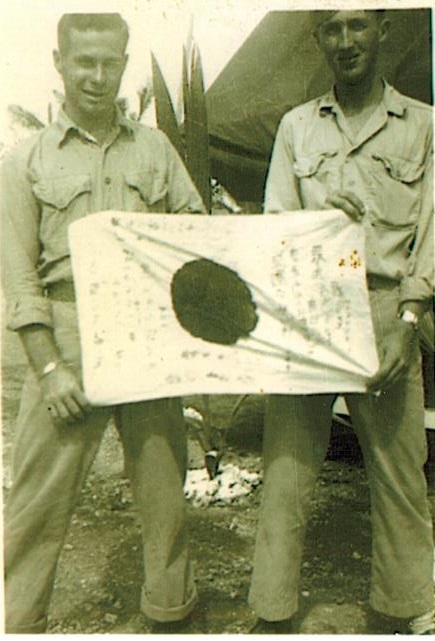
Two members of D Co on Guam - me on the right and do not recall the name of the guy on the left but what's left of my memory believes that he hailed from Rome, Georgia. The flag was "borrowed" for the photo; we did not "capture" it. But, we had to impress our girl friends back home.

Off - loading one of the supply trailers from the Ozark
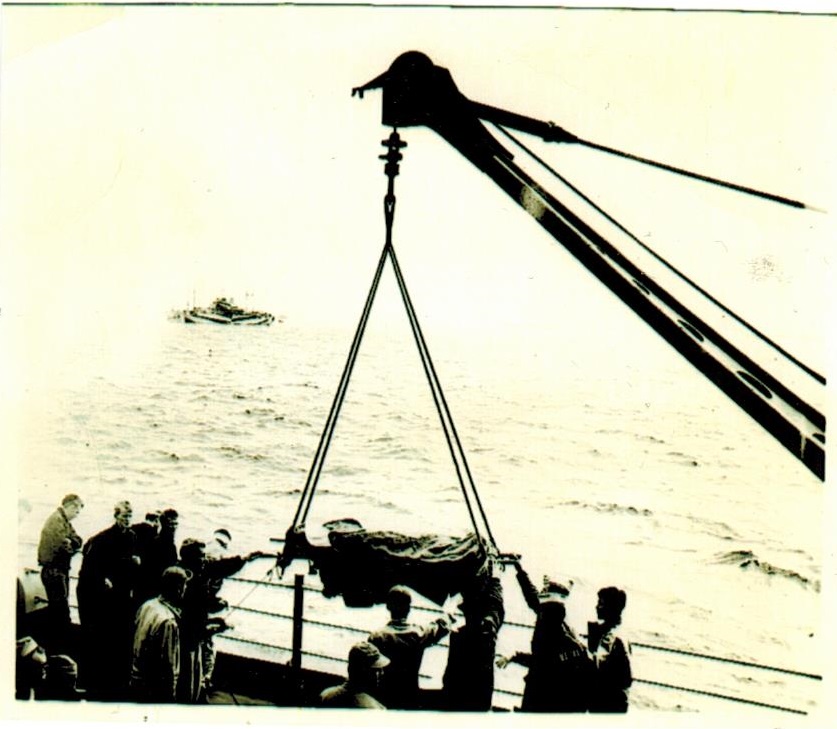
Bringing one of the casualties on board from a Landing Craft.
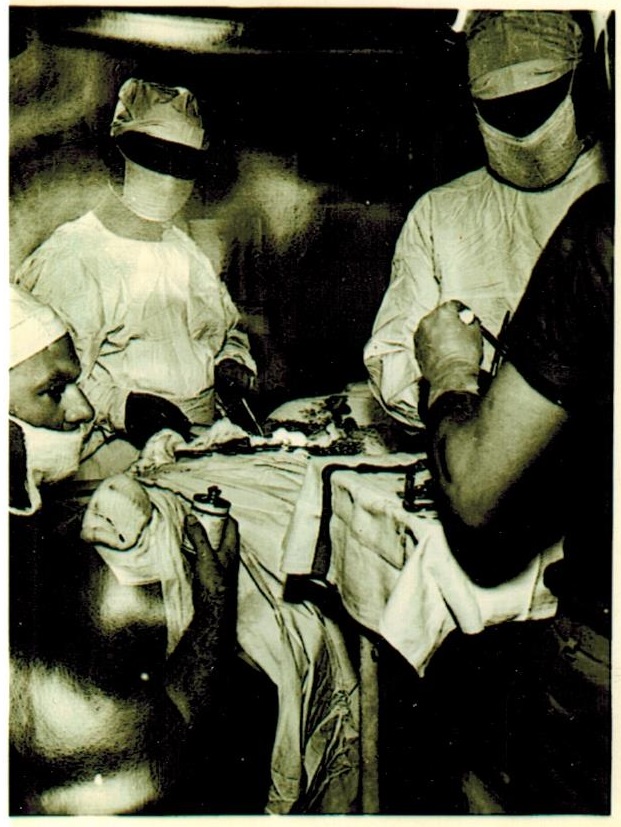
One of the operating teams of D Co at work on the Ozark- not positive, bit I believe the doctor in front of may be Cmdr Abraham Kaplan from NYC, our company CO
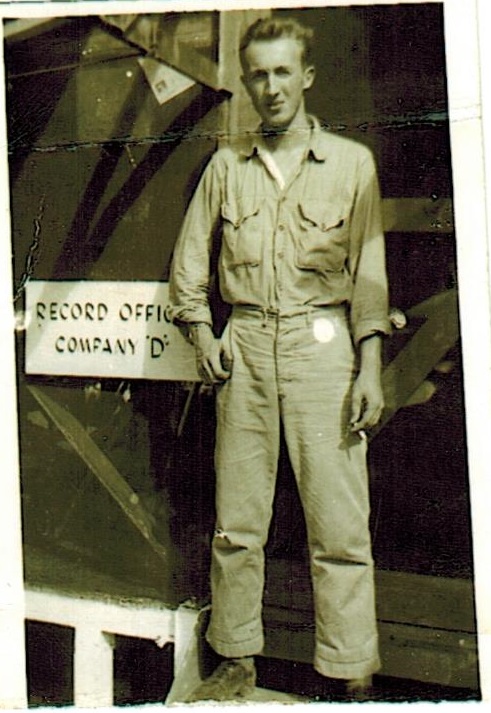
That's me in front of "the office" at the 3rd Marine Division Field Hospital at Ylig Bay on Guam.
----- Ken Rulf
LINKS
Back To Justin Oral History, Marine Biographies
Back To Justin Oral History, Navy Biographies
Also Be Sure to Visit
James F. Justin, Civilian Conservation Corps Museum
Justin Museum of Military History
Please Share your Stories! E-mail the Curator to share or discuss or with any questions!
Copyright 200, 2001-2020 John Justin, All Rights Reserved